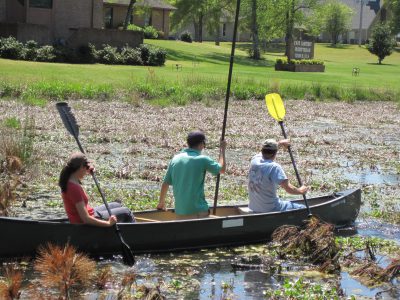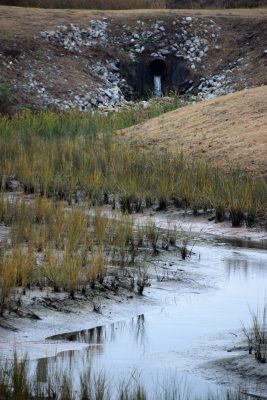
CAPE CARTERET — By all accounts, the North Carolina Coastal Federation’s years-in-the-making project to transform two ponds here into a tidal wetlands stormwater-management system this past summer was a big success.
Of the 18,000 or so wetland plants placed by hand in the basins of the former ponds this past spring, Lexia Weaver, the federation scientist who managed the project, estimates only 5 percent were lost, and the rest have met or even exceeded growth expectations.
Supporter Spotlight

Better still, the constructed wetlands have adequately handled the runoff from several significant rainstorms this fall, including the deluge of several inches over a 48-hour period when Hurricane Matthew moved through the area in October.
“Everything has worked as planned,” Weaver said recently. “We couldn’t be happier.”
In addition, there are already plenty of small baitfish in the system, which is just off N.C. 24 in front of Cape Carteret Baptist Church and Cape Carteret Presbyterian Church. And since the fish are in there, so are birds, including pelicans and egrets.

It’s been a long time coming. Longstanding problems with the ponds were exacerbated in November 2012 when a water control structure failed and the water drained into Deer Creek, which is a tributary of Bogue Sound. Cape Carteret officials contacted the federation to see what could be done, and the organization suggested that the ponds, which were choked by non-native water hyacinths, be turned into wetlands.
The state Division of Water Quality had surveyed the larger pond but said it would not take responsibility to help restore it. The state Department of Transportation also declined to help, despite having four pipes that bring water into the pond from N.C. 24. The Army Corps of Engineers said that the pond pre-dated its permitting process, but if the Corps became involved in fixing the pond, a permit would be needed before any work is done.
Supporter Spotlight
Then the federation closed on the sale of an easement at its massive North River Farms wetlands project east of Beaufort, and collected $3 million. Because the farm project was funded with a state Clean Water Management Trust Fund grant, the proceeds from the sale must be used for similar restoration projects. Federation executive director Todd Miller thought cleaning up the ponds would be a neighborly – and environmentally significant – thing to do with a portion of proceeds.
Eventually, the federation started working in earnest with the town and with the churches, and agreements were reached and all the necessary state and federal permits were obtained. The town’s planning board and board of commissioners signed off on the project early this year, and work to drain the ponds began last winter. Once that was done, Andy and Carson Wood of Habitat Environmental Services of Hampstead, hired by federation, came in and set traps and removed countless fish and many turtles and frogs that had called the ponds home, relocating them to nearby suitable habitat.
That’s when the real work began; with the ponds drained, workers using heavy equipment began “mucking” out the basins, removing mud, vegetation and debris in preparation for planting, operating under a plan designed by Kris Bass of Kris Bass Engineering of Raleigh.
When the mucking was complete, workers began putting in the plants during the last full week of May. The organization worked with an expert, Wes Newell of Backwater and Lumber River Nursery Plants, who has also worked with the federation on the North River Farms property.

Finally, workers removed a filter that had been keeping silt from the project from flowing into Deer Creek and countless fish swam into the newly created wetlands, as did crabs.
Since then, the system has been the beneficiary of daily tidal flows from the creek, and the carefully selected plants have thrived.
Bass, who planned and executed the federation’s 6,000-acre farm-to-wetlands conversion at North River Farms, has called the project “unique” for the state.

The stormwater enters the smaller, upper (farthest from Deer Creek) of the two basins, on the Baptist property, which was rebuilt to have sand and rock layers below the planted vegetation and serves as a bio-retention area, filtering as much of the pollutants as possible from the collected stormwater. The water that remains flows, as a creek, to the larger basin on the Presbyterian property. And the real innovation is that this part of the system is a tidal salt marsh, flooded regularly by water from the creek, which connects to Bogue Sound. The goal, eventually, is to improve the water quality in Deer Creek and to preserve the nearly pristine quality of that section of Bogue Sound.
Weaver said the state Shellfish Sanitation office, which is responsible for monitoring pollution and open and closing shellfish harvest waters, has already been taking samples of the water coming into and leaving the system. Although the data is not yet available, she’s confident the results will show improving water quality.
“Already,” she said, it’s obvious that the “water (in the system) is not coming out as fast as it did,” which means pollutants have more time to settle out and are taken up by the wetlands vegetation.
The next step, Weaver said, will come next year, when the federation and its cadre of volunteers plant oyster shells in the system, in the hope that oyster larvae will attach and grow. Oysters would further clean the water, as they are filter feeders and remove pollutants as they eat.
Bass said he has visited the site in recent weeks and is more than pleased with the results after the first growing season.
“What we are seeing is typical of estuarine creeks, but the growth of the vegetation has actually exceeded our expectations,” he said. “It’s done very well, and we’re looking forward to it (the vegetation) filling in more over the next year or two.”
Bass said the project benefited from a summer and fall growing season that was long, but not overwhelmingly hot for long periods of time, or terribly dry or wet. The tidal flow has been strong, bringing in the saltwater and nutrients that plants need to grow.
Like Weaver, Bass said he’s been pleased by the ability of the system to handle the tremendous amount of stormwater runoff from N.C. 24 and the big commercial parking lots on both sides of the road. But he and Weaver also noted that there have been a couple of erosion problems, one at each basin. Work to fix them has started, as more dirt and rocks are being added to stabilize the banks.
“With a project of this size – it was a pretty major reconstruction – it’s not at all unusual to have a few issues of this type,” Bass said. “The key thing is to watch for them and take care of them before they cause real problems, and that’s what we’re doing.”

The Rev. Ben Burroughs, pastor of the Presbyterian church, said he, too, is pleased, and added that the response from his congregation has been overwhelmingly positive.
“It looks great and of course it seems to be doing what it was supposed to do, which his give us cleaner waters,” he said. “That was what we were primarily after. And we’re looking forward to seeing the vegetation fill in even more over the next year or two.”
Members of the church community, Burroughs said, enjoy the herons and egrets and other wildlife that visit the wetlands, and like seeing the little “winding creek” that runs through the system.
“The federation has been a great partner, and we’re thrilled with the results,” he said. “I’m also pleased that they are paying attention to the little erosion problem and are taking care of it.”
Cape Carteret Mayor Dave Fowler said it was fun to watch the project take shape, and added that he’s heard positive comments from the town’s residents and the board of commissioners.
“I’d say it’s been very successful,” he said. “It looks nice and it will eventually look even better. And most importantly, it’s working the way it was supposed to work.”
The town, he said, is very concerned about water quality, as well as drainage, and officials and residents are very grateful to the federation for taking on a project that didn’t cost taxpayers or the churches any money. He also thinks the project can serve to educate people about ecosystems, another benefit.
“It took a while, but there were a lot of details involved, but it was much more important to get it right than it was to get it done fast,” Fowler said. “We all really appreciate what the federation did.”
When the project was conceived, the cost estimate was around $200,000, but it ended up approaching $500,000.







